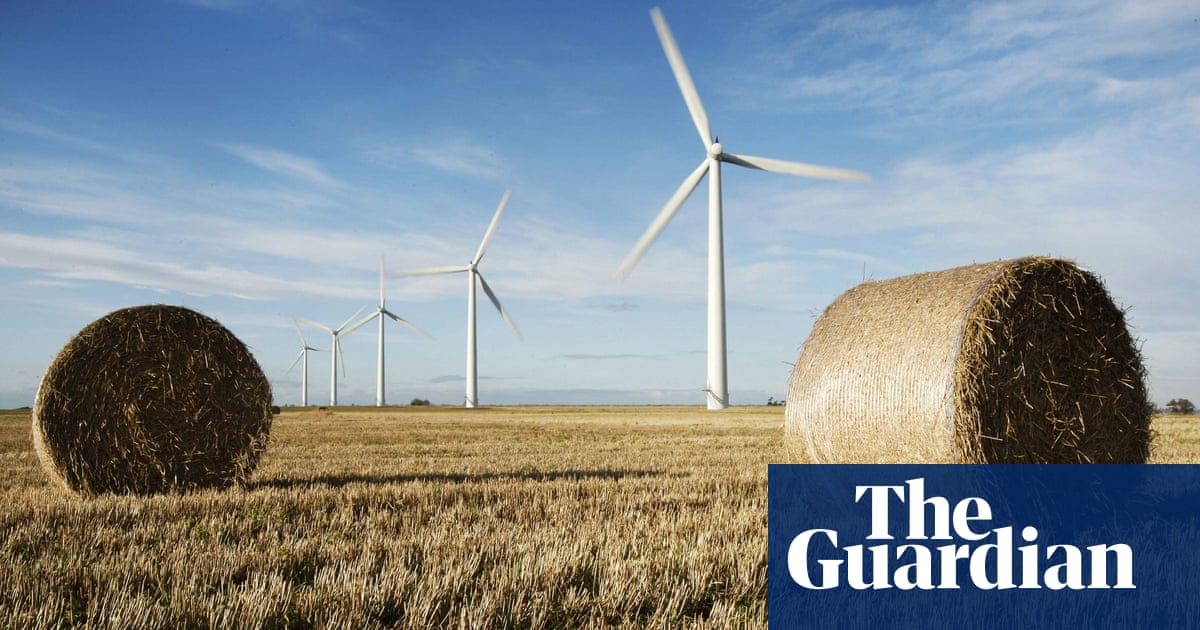England could produce 13 times more renewable energy than it does now, while using less than 3% of its land, analysis has found.
Onshore wind and solar projects could provide enough electricity to power all the households in England two and a half times over, the research by Exeter University, commissioned by Friends of the Earth (FoE), suggested.
Currently, about 17 terawatt hours of electricity a year comes from homegrown renewables on land. But there is potential for 130TWh to come from solar panels, and 96TWh from onshore wind.
These figures are reached by only taking into account the most suitable sites, excluding national parks, areas of outstanding natural beauty, higher grade agricultural land and heritage sites.
Some commentators have argued that solar farms will reduce the UK’s ability to grow its own food, but the new analysis suggests there is plenty of land that can be used without impairing agricultural production. More land is now taken up by golf courses than solar farms, and developers can be required to enhance biodiversity through simple measures such as maintaining hedgerows and ponds.
…
The calculations of the land needed exclude rooftop solar panels. Ministers have resisted calls for solar panels to be made mandatory on new-build housing. Kitting out a new-build home with renewables, high-grade insulation and other low-carbon features costs less than £5,000 for a housing developer, but retrofitting it to the same standard costs about £20,000, with the cost borne by the householder. Housing developers are among the largest donors to the Conservative party.
These figures are reached by only taking into account the most suitable sites, excluding national parks, areas of outstanding natural beauty, higher grade agricultural land and heritage sites.
The calculations of the land needed exclude rooftop solar panels. Ministers have resisted calls for solar panels to be made mandatory on new-build housing. Kitting out a new-build home with renewables, high-grade insulation and other low-carbon features costs less than £5,000 for a housing developer, but retrofitting it to the same standard costs about £20,000, with the cost borne by the householder. Housing developers are among the largest donors to the Conservative party.
I think these are the two most important points in the article tbh. Seems like we could off-set the need to build in national parks etc to meet this potential by adding more solar to roof tops. However, Tories gotta Tory and God forbid the housing developers lose profits. Still great to see what is achievable. We must increase pressure in the government to achieve it.
A distributed grid with lots of little suppliers is hard to manage and less efficient. The only benefit is space and financing. Most people would pay to sponsor a power station (except automatically through pensions), but many would buy solar panels.
The UK also has cold shorter days in the winter and plenty of wind. So wind turbines are going to be a better investment. Additional power connections with Europe would help manage renewable supply and demand.
Putting this cost on homes, is going to upset a lot of voters. Those with properties won’t like the additional cost, or comparative devaluing of property without solar panels. Those buying will be unhappy with the increased house prices, which the papers will blame on solar panels. So it’s a hard battle for any political party in the UK especially with the dominance of right wing media.
Plus the current Prime Ministers non-dom billionaire wife has substantial investment in oil companies. The same oil companies that won extraction right from Israel in Gaza soon after the PM announced his support for Israel’s war in Gaza.
deleted by creator
I hope people start talking about tidal more, there are some great projects suggested and few places in the world have such a good position to take advantage. Solar is still great here but we have a lot of cloud that lowers efficiency, wind is strong but unpredictable so we need over capacity which hampers efficiency until we have good grid-tied industry to use it at peek.
Tide goes in, tide goes out - can’t explain that.
Expensive to build but they can be really long lived so cost per year of life is low - though that doesn’t account for change in construction cost (building 20 year solar farms five times at today’s price can’t be compared to a 100 year tidal barage as twenty years from now solar might cost a tenth of current install costs or less)
It’s all so complex and there’s no one answer to any of it, but there are great answers like solar on industrial rooftops and integrated into infrastructure. Solar on stilts with human and animal walkable space under it needs to be a part of planning too - animal corridors instead of big fences cutting off even more of the land. They built huge fences around the one they’re putting up near me which has blocked routes people and animals have used for years - it’s not green energy if you’re destroying the local environment.
I guess what I’m getting at is there’s a lot of ways we can transition from oil but whatever one we choose we have to do it right and think about the whole picture.
You can’t build any kind of power generation facility without having some negative environmental effect. Tidal power does have quite serious impacts. The Severn Barrage was talked about decades ago, but even as far back as the 80s was seen as too environmentally problematic even though that one scheme alone could produce 7% of the UK’s power (more today given efficiency advances as well as technological advances on the generation side).




